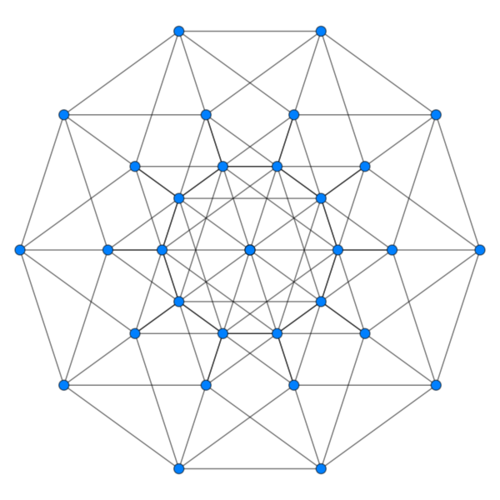5-D on 2-D
 A hypercube in 5 dimensions has
3
2
=
2
5
vertices of the form
(
±
1
,
±
1
,
±
1
,
±
1
,
±
1
)
.
A hypercube in 5 dimensions has
3
2
=
2
5
vertices of the form
(
±
1
,
±
1
,
±
1
,
±
1
,
±
1
)
.
For each pair of distinct vertices, we connect them up with a line segment and mark the midpoint.
How many (distinct) midpoints have been marked?
This section requires Javascript.
You are seeing this because something didn't load right. We suggest you, (a) try
refreshing the page, (b) enabling javascript if it is disabled on your browser and,
finally, (c)
loading the
non-javascript version of this page
. We're sorry about the hassle.
3 solutions
To clarify, the crux move is to notice that every lattice point in or on the n-hypercube is either a vertex or a midpoint of two vertices. Proof: every lattice point is represented by ( 0 or ± 1 , 0 or ± 1 , … 0 or ± 1 ) . The midpoint of any two lattice points is found by taking the average of corresponding coordinates; however, since taking 1 and 1 gives and average of 1 , − 1 and − 1 an average of − 1 , and 1 and − 1 an average of 0 , every lattice point is a midpoint.
For example, the point ( 0 , 1 , 1 , 0 , − 1 ) is the midpoint of ( 1 , 1 , 1 , 1 , − 1 ) and ( − 1 , 1 , 1 , − 1 , − 1 ) .
If you love improper problem solving methods like me, we can find a pattern.
2D square=5 mid points
3D cube=19 mid points.
Looking at all the options, for the nth dimension we have we have
3 n − 2 n , 3 n − 1 , ( 2 verticies ) = ( 2 2 n ) , n 2 , verticies P 2 = 2 n P 2 , 3 n , 2 n , 2 ( 2 verticies ) = 2 ( 2 2 n )
Plugging in n=3 for the above equations yields 19 only for 3 n − 2 n .
Therefore, plugging in n = 5 ⟶ 3 5 − 2 5
Moderator note:
And of course, after you found the pattern, you should try and prove it :)
The coordinates of the mid-point between two vertices are the arithmetic means of the respective coordinates of the two vertices.
Since the vertices coordinates are ± 1 , we have the following possible coordinates for the mid-points: ( { − 1 , 0 , 1 } , { − 1 , 0 , 1 } , { − 1 , 0 , 1 } , { − 1 , 0 , 1 } , { − 1 , 0 , 1 } ) , i.e. a total of 3 5 possibilities.
However, among them there are also the vertices themselves, which we must subtract. Since there are 2 5 vertices, then the number of mid-points is 3 5 − 2 5 .
Moderator note:
Do you mean that "Since the vertices coordinates are ± 1 or 0" instead?
Note that you have only provided a necessary condition for a midpoint. You have not explained why (after removing the vertices) we have a sufficient condition for a midpoint. In other words, we can only be certain that there are at most 3 5 − 2 5 midpoints, but do not yet know the exact number.
Yes, thanks, I edited: { 0 , ± 1 } .
Sorry, but I am a bit confused. What do you mean by "necessary condition" for a midpoint? The midpoint coordinates are the arithmetic means of the respective coordinates of the two vertices.
The formula I wrote considers all the possible midpoints calculated for any couple of vertices. However, these include those couples formed by the same vertex, whose midpoint is the vertex itself which therefore we must subtract. Why isn't this the exact number?
Thank you very much for your feedback.
Log in to reply
Sorry, edited again. I did mean that the vertices coordinates are indeed ± 1 .
Number of vertices in a n-hypercube = 2 n
Number of lattice points in a n-hypercube including all mipoints = 3 n
Number of midpoints = 3 n − 2 n